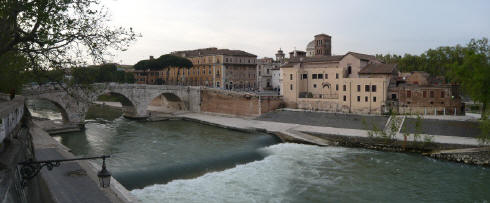The Tiber Island is shaped like a ship in the middle of the Tiber, with two access points: the Cestius Bridge: late 19th century in appearance, but dating back to 46 B.C., of which only the central archway remains, and the Fabricius Bridge, from Roman times.
The ‘bridge’ of the ship houses two churches and two hospitals, while on the eastern quay one can admire a sculpture of the god Aesculapius with a snake twisted around a staff and a bull’s head.
This representation, besides being a reminder of the hospital destination of the place, is meant to recall a legend according to which, during the plague of 292 BC, a snake, consecrated to the Greek god of medicine, spontaneously leapt onto the island from a boat coming from the city of Epidaurus. Two years earlier, in fact, some wise men had travelled to the Greek city to consult the deity following a severe plague.
In memory of this event, the Romans decided to give the island the shape of a ship, shaping blocks of travertine and placing an obelisk in the centre of the temple, erected in honour of Aesculapius, in the form of a mast. On the ruins of the temple today stands the church of San Bartolomeo all’Isola.
